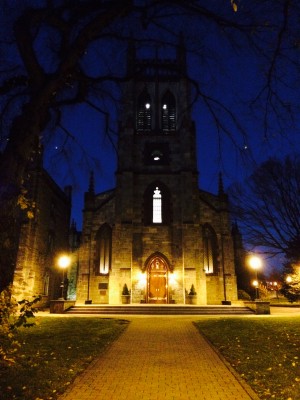Financial Issues Behind NYC Church Mergers
November 20, 2014
On Sunday, Nov. 2, Cardinal Timothy M. Dolan announced the largest reorganization of churches in the history of the Roman Catholic Archdiocese of New York. Fifty-seven parishes will close and merge with neighboring parishes by August of 2015.

(Lauren Macdonald / The Observer)
“When we knew we were on the list to merge, they gave us an opportunity to appeal,” Donna Lajoux, executive secretary of Fordham University campus ministry, said. Lajoux is a member of St. Gabriel’s of Riverdale, which is now set to merge. She was employed as the bookkeeper there from 2005 until she began working in the Campus Ministry office at Fordham College at Lincoln Center (FCLC) in October. “And we did appeal. Now, I think [the closure]’s pretty much set in stone,” she said.
This consolidation is one in a trend that has been going on for decades. This reorganization involved all 386 parishes in the New York City area, which were warned that they were under review. Fifty-seven churches will now prepare to close in coming months.
“This is not just going on in New York,” Rev. John J. Shea, S.J., director of Fordham’s campus ministry, said. “It’s going on across the nation. And it’s a difficult decision for bishops because it doesn’t look good if you’re closing parishes. You should be growing, not shrinking.”
According to Shea, the mergers stem from financial problems, “[The parishioners], themselves, don’t have the money to personally keep it going,” he said. “And unfortunately in many of the big cities, unlike in the suburbs, many of the churches are old and take a lot of heavy expenses.” Shea also cited a widespread shortage of priests as a factor. According to Pew Research Center, the number of priests in the United States has been slowly but steadily declining over the last 50 years.
Fordham Professor John Seitz, Ph.D., explained, “What the bishops are looking at are: ‘Who’s in the parish?’ ‘Who’s getting their sacraments performed there?’ ‘Are there other parishes nearby that can serve those needs?’ So they’re taking a businesslike approach to the problem.”
Seitz also agreed with Shea that money was a factor. “An important consideration is the financial straits of Catholic dioceses, the difficulties they have in paying their bills … linked to, in some cases, bad management of funds, or payments to settle claims for sexual abuse victims. So it’s a layered story, not just one explanation,” Seitz said.
According to the Archdiocese of New York, only 12 percent of its 2.6 million Catholics regularly attended Sunday Mass last year. Both Shea and Seitz attributed the pattern of urban church closings to the population shifts after a wave of suburbanization that took place in and after the 1950s. Shea said, “The demographics have changed from where people used to live. Many of them were ethnic parishes connected with the Irish, Italian, German [populations] and those parishes flourished. But now people have moved out, moved on … so you have more churches than you have people to fill them.”
According to Pew Research Center, each generation has had lower religious affiliation rates since the Greatest generation, born before 1928. Today’s youth born after 1980, has the lowest church attendance rate of all.
Shea compared the loss of a church to the loss of a home. “In my parish, the grammar school closed, the rectory closed, the nuns are gone from the convent, and that’s the church where I received communion, confirmation, my first mass,” he said. “It’s hard to see that go … For these people, their whole lives have been in that church. They grew up there, it’s like a family.”
Lajoux said the same of St. Gabriel’s. “It’s a small church … we had about 600 people coming to church every weekend … We had lots of families, lots of parishioners who are third, fourth generation there, so it’s very heartbreaking.” She continued, “It might have been a small church. But it had a feeling of the parish of a cathedral. It was very loyal people, and we had great volunteers, great ministries.”
Lajoux also expressed her worries about the accessibility of St. Margaret’s for some St. Gabriel’s parishioners. “It’s very hilly in Riverdale,” she said. “I think for a lot of senior citizens, and for many of the young mothers with strollers and families that we serve … I’m sure that it will be difficult [to walk there].”
Seitz said that there are ways that parishes can appeal these kinds of decisions, but it is a very expensive process and very time-consuming to make the way through the Catholic system of canon law, and in the places he’s studied such as Boston, appeals are usually denied by higher levels of authority.
“It’s a really dicey proposition to be closing a parish,” he said, “because for the entire life of the parish, the [parishioners have] been hearing from the pastors that ‘this place is your spiritual home,’ … There’s a lot of investment in these places, and sometimes the logic of business seems to violate those histories. It’s revealing about what we care about, what we value, whether or not a place is worth preserving.
“The bishops make the case that this is like a dying and a resurrection: we have to die in order to be reborn, that’s a basic Christian argument,” Seitz said.
According to Lajoux, that rebirth might take some time, as there is definitely a mourning period. “[Our pastor’s] been open and honest with us from day one, and we just have to now move forward, as sad as it is.”









